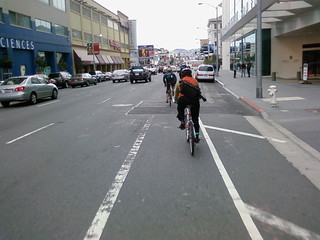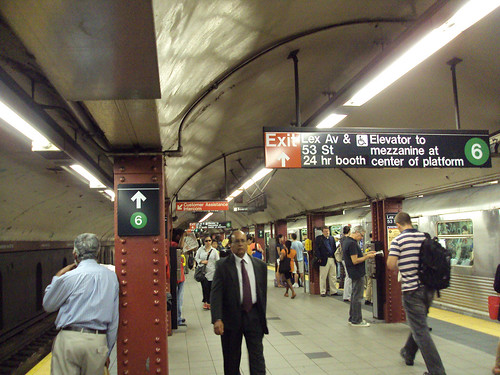Which US metros have the greenest commuting habits?

Posted October 25, 2012 at 1:42PM
As most readers know only too well, the US pales by comparison to the rest of the world when it comes to getting around by anything other than single-occupancy cars. Starting in the 1950s, we fell in love with spread-out living and with automobiles in a way that other countries didn’t, at least not to the same degree. (Even Canadians and Australians don’t drive as much as we do.) We soon simply (and wrongly) assumed that everyone could and should drive to do most anything, and built our suburbs accordingly, guaranteeing that the trend would perpetuate.
Slowly but surely, the trend is now beginning to reverse as the hot markets are in downtowns and walkable neighborhoods, with the ones having good transit service commanding the highest premiums on a per-square-foot basis. But we have a long, long way to go.
(Disclosure: As my enviro colleagues know, I am not a purist on these matters. I have a very nice car, thank you very much, and I happen to love it. But I am also fortunate to live somewhere that allows me to leave it parked much of the time. I get to choose when to drive; most Americans don’t have that choice, unfortunately. Yet.)
 As pathetic as we are when it comes to our lack of realistic transportation choices – we’ve built and grown our newer communities in a way that makes transit ridiculously inefficient and walking anywhere important just about impossible – some US metro areas perform much better than others in enabling greener travel habits. Which ones? Glad you asked.
As pathetic as we are when it comes to our lack of realistic transportation choices – we’ve built and grown our newer communities in a way that makes transit ridiculously inefficient and walking anywhere important just about impossible – some US metro areas perform much better than others in enabling greener travel habits. Which ones? Glad you asked.
Last month, Aaron Renn, a city analyst best known for his terrific blog Urbanophile, published a highly informative summary of the newest commuting data in the online journal newgeography. While it focuses on trips to and from work and not all trips, Aaron’s summary gives us a pretty good picture of how we get around and to what extent our daily transportation habits may be changing. It contains both good and bad news for people such as myself who would like to see our patterns become greener as quickly as possible.
Aaron’s analysis is based on 2011 data from the American Community Survey, a product of the US Census Bureau. I’ll hit the highlights here, and you can go to the article for more detail.
First (and this won’t be surprising), New York City dominates in transit usage, with a metro commute mode share for transit of 31.1 percent and an estimated 2,686,406 transit commuters. The rest of the country combined adds only 3,530,932 transit commuters. This means that the Big Apple accounts for a whopping 39 percent of all transit commuters in the United States. The Washington, DC metro area is second in transit mode share at 14.8 percent, and the San Francisco Bay area a close third at 14.6 percent. Only five American cities have a transit mode share of even 10 percent.
Moreover, only New York and Washington significantly increased their transit mode shares in the last decade. I was a little surprised not to see big gains in Denver, Dallas and San Diego, given those areas’ recent transit investments. (Charlotte and Los Angeles, which have also made significant investment in the last decade, did register gains in transit mode share, but both increased by less than one percent compared to 2000.)
 New York also leads the way in walking to work with a 6.3 percent mode share, but other metros are much closer to matching New York’s performance on walking than they are with regard to matching its transit usage. Boston and the San Francisco Bay Area are second and third at 5.3 percent and 4.3 percent, respectively. Portland has the most bike commuters, followed by three California metros: the Bay Area, San Jose/Silicon Valley, and Sacramento. (I guess weather helps, Portland notwithstanding.) Those four metros are the only ones where the bike commuting share approaches or (slightly) exceeds two percent.
New York also leads the way in walking to work with a 6.3 percent mode share, but other metros are much closer to matching New York’s performance on walking than they are with regard to matching its transit usage. Boston and the San Francisco Bay Area are second and third at 5.3 percent and 4.3 percent, respectively. Portland has the most bike commuters, followed by three California metros: the Bay Area, San Jose/Silicon Valley, and Sacramento. (I guess weather helps, Portland notwithstanding.) Those four metros are the only ones where the bike commuting share approaches or (slightly) exceeds two percent.
The percentage of people who work from home is significant and somewhat higher than the portion who walk. Austin leads the way with a 7.1 percent work-from-home share.
Aaron also presents the ten US metro areas with the longest commute times. I think the real finding from that list is that everyone in big cities takes more or less half an hour to get to work. Number one New York and number ten Philadelphia are separated by only six minutes at 34.9 and 28.5 minutes, respectively. I’ve heard knowledgeable analysts say that, actually, the 30-minute commute has been fairly stable for centuries; only the modes and distances have changed.
It is interesting to compare these data with a similar summary that I wrote three years ago. I think Aaron’s is more meaningful, not only because it is more current but also because metro data are more telling than central-city data, which are what I had to work with. That said, there is a lot of consistency among the top performers.
Related posts:
- Where the bike commuters are, mapped & analyzed (August 10, 2012)
- Central cities now growing faster than suburbs, confirming trends for walkable lifestyles, shorter commutes (June 29, 2012)
- New data confirm European transportation habits are much greener than those in US cities (October 27, 2011)
- "Your commute is killing you" (June 3, 2011)
- We will take transit if it meets our needs (IOW, don’t fall for “the fundamental attribution error”) (March 18, 2010)
- Which US cities have the greenest commuting habits? (October 2, 2009)
- NatGeo surveys countries' transit use: guess who comes in last (May 18, 2009)
Move your cursor over the images for credit information.

